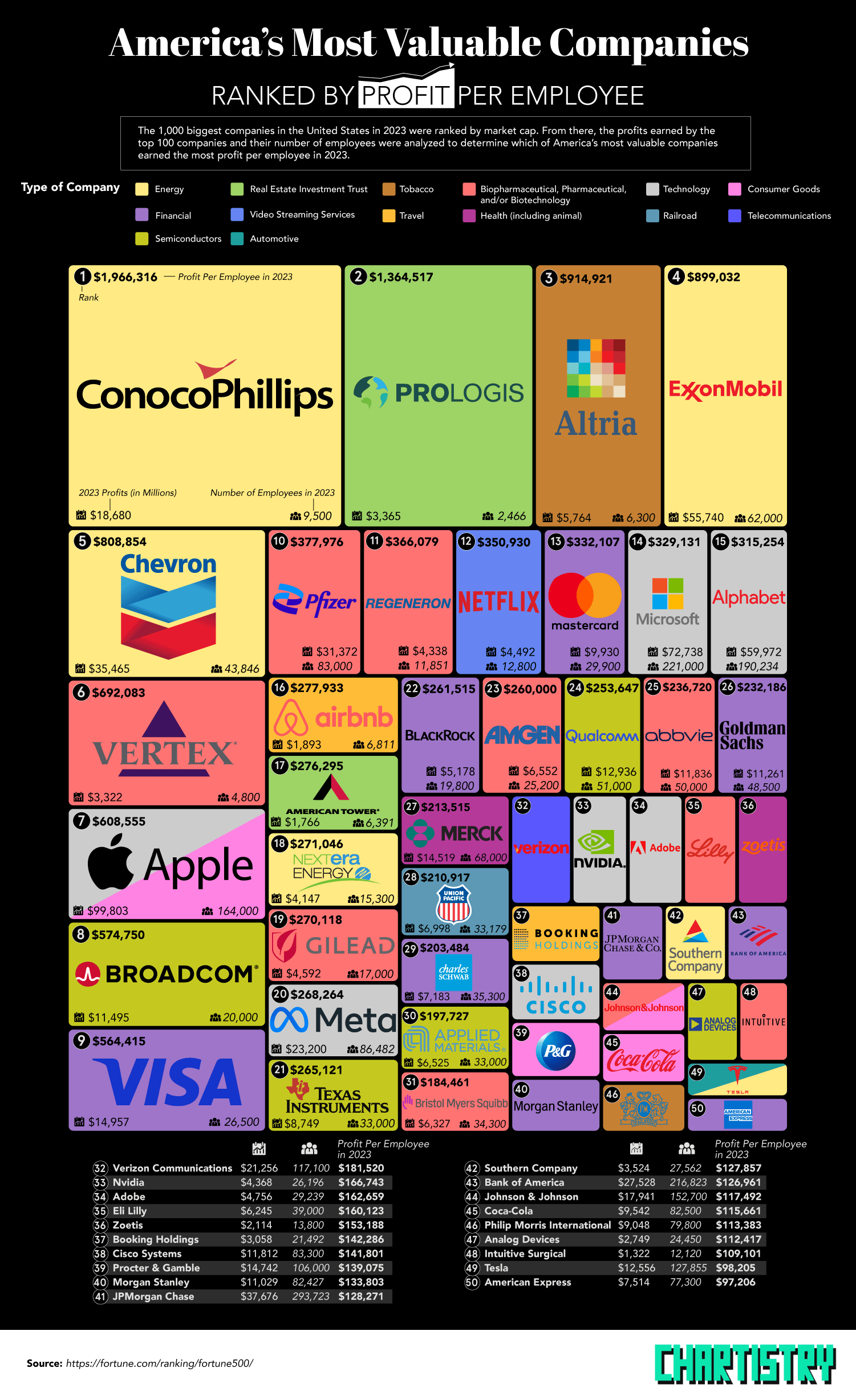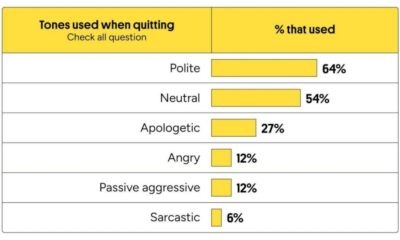Business Visualizations
America’s Most Valuable Companies Ranked by Profit per Employee
Ever wonder how much money major corporations make per employee? Profit Per Employee (PPE) is determined by dividing the company’s profit by the company’s quantity of full-time employees. The most profitable companies may not necessarily be the most profitable by number of employees—and vice versa. Whenever the economy is uncertain, this formula is usually one of the metrics companies will monitor to determine the efficiency and productivity of their staff. Using data over profit and company size from 2023, our team at The Chartistry has ranked the top 50 companies with the highest profit per worker.
Click below to zoom
With a profit of nearly $2 million for each of their 9,500 employees, ConocoPhillips ranks first for highest profit per employee by quite the large margin. ConocoPhillips, an American oil and gas producer, saw a total profit almost $18.7 billion in 2023. Since oil and gas are two of the most valuable energy commodities in the world, it is not uncommon for an energy company to rank high in terms of PPE since their net profit is typically quite expansive. Of the top 50 companies with the highest profit for every employee, six of them can be categorized under the energy sector.
Coming in second place, Prologis is an investment trust company that saw a total profit of $3.4 billion in 2023. This profit was divided by their 2,466 employees to end with a profit of $1.36 million per employee.
In third, there is the tobacco company Altria Group. Altria Group’s 2023 profit of $5.8 billion was divided by 6,300 employees to result in a profit per employee of $915 thousand. Tobacco is yet another commodity product, with only one other tobacco company making the top 50 ranking.
Exxon Mobil is another oil and gas company with high profit per employee, coming in fourth place. Out of their profit of $55.7 million in 2023, their 62,000 employees averaged a profit of $899 thousand each.
Rounding out the top 5 companies is Chevron, the third oil and gas energy company in the top companies by profit per employee. With a total profit of $35.3 million, their PPE comes out to $809 thousand for each of their 43,846 employees.
Some companies land rank in both the most profitable in the world overall as well as in profit per worker. Apple, for example, brought in a 2023 profit of nearly a $100 billion. The company itself is valued at a total of $2.1 trillion. They managed a PPE of $609 thousand for their 164,000 employees, making them seventh among all companies.
Why is Profit per Employee Important?
For every company with an impressive profit per employee, there are tens, hundreds, even thousands of people working at the front line and behind the scenes to keep operations running as smoothly and efficiently as possible. PPE, not to be confused with Revenue per Employee, is a way for the company to measure the performance and productivity of the average employee in any given workforce to judge their added value. In other words, a way to know if their investment in hiring, retaining, and training their employees returned desirable results. Of course, it isn’t and shouldn’t be the only method to judge the value of an employee. When used in combination with other metrics, however, it can be a helpful tool to see the what employees have brought to the company.
For the majority of situations, a healthy profit per employee will be a good indicator of the health of the company at large. It shows that the business is properly maximizing the streamlining of their operations and utilizing the talent of each employee. This performance can mean that an underwhelming PPE may lead to cost-cutting measures for the company. Oftentimes, this is in the form of employee layoffs in areas that may not be contributing to the overall profit.
Did You Enjoy this Original Visualization by The Chartistry?
If you enjoyed this visualization and analysis by The Chartistry, check out the other original visualizations we’ve created. For even more great content, check out our collection of curated business and finance visualizations. If you love this visual content so much that you want your own, let us know; We design custom visual content for customers too!
The Profit per Employee of the Largest Companies in the U.S. By Market Cap (The Full List)
Which corporations have the highest revenue per employee? Companies that are able to do more with less:
| Rank | Name | Type of Company | 2023 Profits (in Millions) | Number of Employees in 2023 | Profit per Employee in 2023 |
| 1 | ConocoPhillips | Energy | $18,680 | 9,500 | $1,966,316 |
| 2 | Prologis | Real Estate Investment Trust | $3,364.9 | 2,466 | $1,364,517 |
| 3 | Altria Group | Tobacco | $5,764 | 6,300 | $914,921 |
| 4 | Exxon Mobil | Energy | $55,740 | 62,000 | $899,032 |
| 5 | Chevron | Energy | $35,465 | 43,846 | $808,854 |
| 6 | Vertex Pharmaceuticals | Biopharmaceutical, Pharmaceutical, and/or Biotechnology | $3,322 | 4,800 | $692,083 |
| 7 | Apple | Technology, Consumer Goods | $99,803 | 164,000 | $608,555 |
| 8 | Broadcom | Semiconductor | $11,495 | 20,000 | $574,750 |
| 9 | Visa | Financial | $14,957 | 26,500 | $564,415 |
| 10 | Pfizer | Biopharmaceutical, Pharmaceutical, and/or Biotechnology | $31,372 | 83,000 | $377,976 |
| 11 | Regeneron | Biopharmaceutical, Pharmaceutical, and/or Biotechnology | $4,338.4 | 11,851 | $366,079 |
| 12 | Netflix | Video Streaming Services | $4,491.9 | 12,800 | $350,930 |
| 13 | Mastercard | Financial | $9,930 | 29,900 | $332,107 |
| 14 | Microsoft | Technology | $72,738 | 221,000 | $329,131 |
| 15 | Alphabet | Technology | $59,972 | 190,234 | $315,254 |
| 16 | Airbnb | Travel | $1,893 | 6,811 | $277,933 |
| 17 | American Tower | Real Estate Investment Trust | $1,765.8 | 6,391 | $276,295 |
| 18 | NextEra Energy | Energy | $4,147 | 15,300 | $271,046 |
| 19 | Gilead Sciences | Biopharmaceutical, Pharmaceutical, and/or Biotechnology | $4,592 | 17,000 | $270,118 |
| 20 | Meta Platforms | Technology | $23,200 | 86,482 | $268,264 |
| 21 | Texas Instruments | Semiconductor | $8,749 | 33,000 | $265,121 |
| 22 | BlackRock | Financial | $5,178 | 19,800 | $261,515 |
| 23 | Amgen | Biopharmaceutical, Pharmaceutical, and/or Biotechnology | $6,552 | 25,200 | $260,000 |
| 24 | Qualcomm | Semiconductor | $12,936 | 51,000 | $253,647 |
| 25 | AbbVie | Biopharmaceutical, Pharmaceutical, and/or Biotechnology | $11,836 | 50,000 | $236,720 |
| 26 | Goldman Sachs Group | Financial | $11,261 | 48,500 | $232,186 |
| 27 | Merck | Health (Including Animals) | $14,519 | 68,000 | $213,515 |
| 28 | Union Pacific | Railroad | $6,998 | 33,179 | $210,917 |
| 29 | Charles Schwab | Financial | $7,183 | 35,300 | $203,484 |
| 30 | Applied Materials | Semiconductor | $6,525 | 33,000 | $197,727 |
| 31 | Bristol-Myers Squibb | Biopharmaceutical, Pharmaceutical, and/or Biotechnology | $6,327 | 34,300 | $184,461 |
| 32 | Verizon Communications | Telecommunications | $21,256 | 117,100 | $181,520 |
| 33 | Nvidia | Technology | $4,368 | 26,196 | $166,743 |
| 34 | Adobe | Technology | $4,756 | 29,239 | $162,659 |
| 35 | Eli Lilly | Biopharmaceutical, Pharmaceutical, and/or Biotechnology | $6,244.8 | 39,000 | $160,123 |
| 36 | Zoetis | Health (Including Animals) | $2,114 | 13,800 | $153,188 |
| 37 | Booking Holdings | Travel | $3,058 | 21,492 | $142,286 |
| 38 | Cisco Systems | Technology | $11,812 | 83,300 | $141,801 |
| 39 | Procter & Gamble | Consumer goods | $14,742 | 106,000 | $139,075 |
| 40 | Morgan Stanley | Financial | $11,029 | 82,427 | $133,803 |
| 41 | JPMorgan Chase | Financial | $37,676 | 293,723 | $128,271 |
| 42 | Southern Company | Energy | $3,524 | 27,562 | $127,857 |
| 43 | Bank of America | Financial | $27,528 | 216,823 | $126,961 |
| 44 | Johnson & Johnson | Biopharmaceutical, Pharmaceutical, and/or Biotechnology | $17,941 | 152,700 | $117,492 |
| 45 | Coca-Cola | Consumer Goods | $9,542 | 82,500 | $115,661 |
| 46 | Philip Morris International | Tobacco | $9,048 | 79,800 | $113,383 |
| 47 | Analog Devices | Semiconductor | $2,748.6 | 24,450 | $112,417 |
| 48 | Intuitive Surgical | Biopharmaceutical, Pharmaceutical, and/or Biotechnology | $1,322.3 | 12,120 | $109,101 |
| 49 | Tesla | Automotive, Energy | $12,556 | 127,855 | $98,205 |
| 50 | American Express | Financial | $7,514 | 77,300 | $97,206 |
Business Visualizations
New Study Examines Language Used to Let Employees Go
Letting an employee go is an unpleasant experience for everyone involved, but language has the power to guide the emotions surrounding an interaction. While the right words won’t erase the bad side of being let go, they can help the employee in question understand why the situation is happening and make them feel seen and heard. Preply leaned into the language aspects in these situations with a study examining the most common phrases and words used when letting an employee go and how employers and employees felt about the situation.
Click below to zoom.
Overall, the team found that these were the most common phrases used:
- Letting you go
- Effective immediately
- Terminating your employment
- This isn’t working out
- No longer require services
- Parting ways
- Ending your employment
- No longer needed
- Relieved of duties
- Ending our working relationship
Managers and employees seem to agree that lack of empathy and responsibility were the most common complaints about the process. One in six managers say they regret the words they chose when firing someone, and 92% feel they need more training on how to handle such situations. Employees wanted their managers to focus on clarity, compassion, empathy, and honesty when firing an employee.
The team studied changes that both managers and employees would like to see in the firing process.
These are the six things employees want to see improved:
- Better explanation
- Better empathy
- Taking responsibility rather than avoiding blame
- Face-to-face conversation rather than electronic
- Fewer team members involved in the firing
- Don’t compare fellow employees
Here’s how that compares to changes managers would like to make to the process:
- Better explanation
- Better empathy
- Face-to-face conversation rather than electronic
- Don’t compare fellow employees
- Taking responsibility rather than avoiding blame
- Fewer team members involved in firing
These are similar answers, but we can see that the two groups ranked their importance differently. Overall, 92% of Americans think managers could benefit from some language training when it comes to firing someone. Empathy and honesty were high on the list of employee wishes, indicating that understanding can help give them closure on the job, and empathy softens the blow. Not many managers would prefer a face-to-face meeting. Only 1 in 6 prefer this to virtual meetings, which seem to be the most common option.
Only 55% of managers have received training on how to fire someone, and with many of them regretting their language choices, it seems that many managers would benefit from some education in business language and communication. Notice that many of the top phrases are more professional ways to say “fired,” like “letting you go,” “terminating,” and “no longer require.”
When managing a team, empathy and clear language are crucial. These skills can help managers excel at many tasks beyond having to let an employee go. But when a situation like firing someone is emotionally charged, the language used becomes more important than ever. Hopefully, the team’s study can help managers reflect on how they go about the process.
Business Visualizations
Study Examines the Ways Americans Resign from Jobs
Over 1,000 Americans responded to a survey from the Preply team that studied how Americans communicate when they quit their jobs. In 2025, over 3 million Americans quit their jobs, clearly indicating resigning is a common occurrence. But this study reveals that people have different approaches to quitting, as well as some commonalities. The team’s analysis encompasses the methods used to resign as well as the tone, language, and feelings surrounding the resignation.
Click below to zoom.
Most Americans reported a verbal resignation. 76% of the survey responders used this direct and personal approach to quit their jobs, while only 9% gave a handwritten notice of resignation. That’s surprisingly fewer than the number who “ghosted” their employer at 19%. Around 10% of workers quit via text, leading to 43% reporting that their resignation only lasted a few minutes. Quitting can be awkward and uncomfortable, so it makes sense that people want to get the conversation over with. Those who quit in letter or text said they sent “just a few words.”
The next aspect the team considered was the tone and language used in the resignation. Naturally, many employees would want to avoid burning bridges when they quit. 91% of employees said they avoided using negative or critical language when resigning. 64% said they were conscious of using a polite tone, and 27% went as far as using apologetic tones and words. 60% of employees had to suppress their negative emotions and refrained from stating the critical reasons that led to their resignation.
There were some differences among ages and genders as well. Gen Z was the most restrained when resigning, with 61% stating that they held back emotions during the process. Boomers and Gen X were similar at 59% and 58% respectively. Millennials held back the least at 57%. As for gender, 63% of women said they suppressed their emotions and 53% of men reported the same. The team found that when employers offered exit interviews, 40% of workers felt more comfortable expressing their honest experiences at the company, which is important for companies that take worker experience and company culture seriously.
Most people said they avoided language, but here’s the specific breakdown of the tones they used when they quit:
- Polite – 64%
- Neutral – 54%
- Apologetic – 27%
- Angry – 12%
- Passive-aggressive – 12%
- Sarcastic – 6%
While people may hold back their negative feelings when resigning, that doesn’t mean these employees are above cutthroat tactics. One in eight people said they chose to resign at a time when they knew it would cause the most disruption and harm at work. Gen Z was the most likely to do this, and men were more likely than women. One in ten left negative or scathing reviews of their former company on sites like Glassdoor. Healthcare workers were the most likely to do this. These reviews often included negative words like “disorganized”, “stressful”, and “frustrating.” These written reviews often express things employers weren’t comfortable saying in person.
The trends and findings in this study provide a well-rounded look at a common experience, revealing surprising similarities among people in very different situations.
Business Visualizations
Which Products Will Consumers Spend More on in 5 Years?
The team at LLC Attorney analyzed business and economic trends to determine which products consumers will spend the most on over the next five years. Analysts invest a lot of effort into predicting spending trends to get ahead of the curve. Consumers can benefit from this data by using it to guide savings and create a budget. The team used their data to identify the individual categories that might see the highest spending and then determined how much prices may increase for products in these categories.
Click below to zoom.
Experts expect these products to see the biggest spending increase between 2025 and 2029:
- Food
- Tobacco
- Household Essentials
- Online Education
- Beverages
- Luxury Goods
- Fashion
- E-Services
- OTC Pharmaceuticals
- Furniture
Analysts predict consumers will spend $389 on food in 2029, which is a 12% increase. Food will always be a high-spending category since it’s a necessity. Inflation hit grocery prices hard, and those prices rarely go back down. Part of the reason grocery prices have increased is that busy lifestyles are driving consumers to spend more on convenience food and meal kits. At the same time, rising restaurant prices drive more people to cook at home, which means a greater spend on ingredients.
The team’s data shows specific food, beverage, and tobacco products with the largest projected spending increases:
- Fish and Seafood
- Oils and Fats
- Sauces and Spices
- Bread and Cereal Products
- Spreads and Sweeteners
- Confectionery and Snacks
- Meat
- Dairy Products and Eggs
- Fruits and Nuts
- Vegetables
Outside of those three categories, these specific products have the highest projected spending increase:
- Tissue and Hygiene Paper
- Luxury Watches and Jewelry
- Online University Education
- Luxury Fashion
- Home and Laundry Care
- Accessories
- Luxury Leather Goods
- Beauty Tech
- Grocery Delivery
- Prestige Cosmetics and Fragrances
It may be surprising to see tobacco spending increase so much. Surveys show that young adults are using more tobacco than the previous generation because of the popularity of vapes and e-cigarettes. “Vice markets” tend to rise in periods of economic strain, so the sales very well may hold firm.
The household essentials category is similar to high grocery spending. Toilet tissue is an essential item, and the COVID-19 pandemic drove up spending on cleaning products. It seems many Americans haven’t relaxed their cleaning standards since then.
A combination of current trends and expert analysis on consumer behavior leads to these spending predictions. Demographics, interests, needs, and economic stability all contribute to a population’s spending habits. Not all trends are predictable. Significant events like warfare and natural disasters can dramatically impact prices and spending habits in ways that economists may not be able to predict. While not every change can be expected, this data can still provide an accurate forecast, and consumers should pay attention to areas where prices are set to increase. Perspective business owners can also use this information to their advantage and find opportunities for areas that will be in high demand in a few years.
-
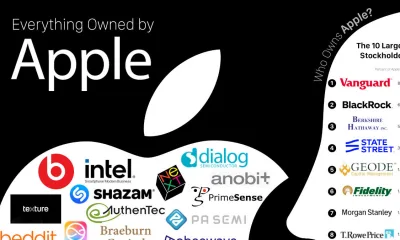
 Business Visualizations1 year ago
Business Visualizations1 year agoEverything Owned by Apple
-
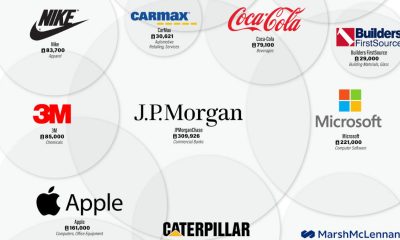
 Business Visualizations6 months ago
Business Visualizations6 months agoThe Biggest Employers by Industry
-
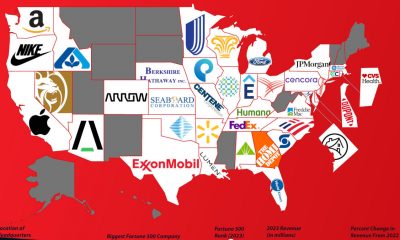
 Business Visualizations8 months ago
Business Visualizations8 months agoThe Biggest Fortune 500 Company in Every State
-

 Maps2 years ago
Maps2 years agoPenis Lengths Around the World
-
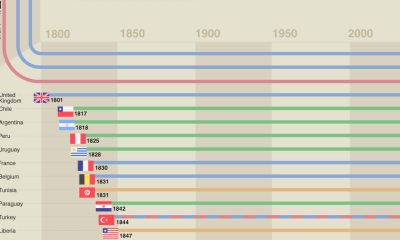
 Timelines2 years ago
Timelines2 years agoA History of the Oldest Flags in the World
-
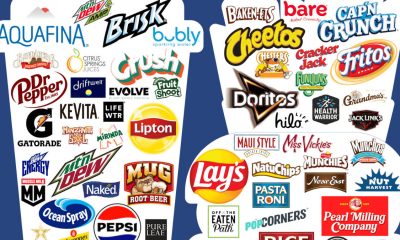
 Business Visualizations2 years ago
Business Visualizations2 years agoAll The Brands Owned By PepsiCo
-

 Business Visualizations2 years ago
Business Visualizations2 years agoNew Animated Map Shows Airbnb’s Fully Booked Cities Along the 2024 Eclipse Path of Totality
-
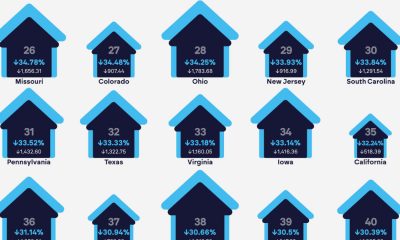
 Charts2 years ago
Charts2 years agoReal Estate Chart Reveals Your Money Has Only 50-80% of the Buying Power it Did 5 Years Ago

